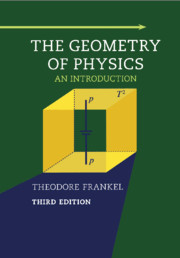Book contents
- Frontmatter
- Contents
- Preface to the Third Edition
- Preface to the Second Edition
- Preface to the Revised Printing
- Preface to the First Edition
- Overview. An Informal Overview of Cartan's Exterior Differential Forms, Illustrated with an Application to Cauchy's Stress Tensor
- I Manifolds, Tensors, and Exterior Forms
- 1 Manifolds and Vector Fields
- 2 Tensors and Exterior Forms
- 3 Integration of Differential Forms
- 4 The Lie Derivative
- 5 The Poincaré Lemma and Potentials
- 6 Holonomic and Nonholonomic Constraints
- II Geometry and Topology
- III Lie Groups, Bundles, and Chern Forms
- Appendix A Forms in Continuum Mechanics
- Appendix B Harmonic Chains and Kirchhoff's Circuit Laws
- Appendix C Symmetries, Quarks, and Meson Masses
- Appendix D Representations and Hyperelastic Bodies
- Appendix E Orbits and Morse–Bott Theory in Compact Lie Groups
- References
- Index
1 - Manifolds and Vector Fields
from I - Manifolds, Tensors, and Exterior Forms
Published online by Cambridge University Press: 05 June 2012
- Frontmatter
- Contents
- Preface to the Third Edition
- Preface to the Second Edition
- Preface to the Revised Printing
- Preface to the First Edition
- Overview. An Informal Overview of Cartan's Exterior Differential Forms, Illustrated with an Application to Cauchy's Stress Tensor
- I Manifolds, Tensors, and Exterior Forms
- 1 Manifolds and Vector Fields
- 2 Tensors and Exterior Forms
- 3 Integration of Differential Forms
- 4 The Lie Derivative
- 5 The Poincaré Lemma and Potentials
- 6 Holonomic and Nonholonomic Constraints
- II Geometry and Topology
- III Lie Groups, Bundles, and Chern Forms
- Appendix A Forms in Continuum Mechanics
- Appendix B Harmonic Chains and Kirchhoff's Circuit Laws
- Appendix C Symmetries, Quarks, and Meson Masses
- Appendix D Representations and Hyperelastic Bodies
- Appendix E Orbits and Morse–Bott Theory in Compact Lie Groups
- References
- Index
Summary
Better is the end of a thing than the beginning thereof.
Ecclesiastes 7:8As students we learn differential and integral calculus in the context of euclidean space ℝn, but it is necessary to apply calculus to problems involving “curved” spaces. Geodesy and cartography, for example, are devoted to the study of the most familiar curved surface of all, the surface of planet Earth. In discussing maps of the Earth, latitude and longitude serve as “coordinates,” allowing us to use calculus by considering functions on the Earth's surface (temperature, height above sea level, etc.) as being functions of latitude and longitude. The familiar Mercator's projection, with its stretching of the polar regions, vividly informs us that these coordinates are badly behaved at the poles: that is, that they are not defined everywhere; they are not “global.” (We shall refer to such coordinates as being “local,” even though they might cover a huge portion of the surface. Precise definitions will be given in Section 1.2.) Of course we may use two sets of “polar” projections to study the Arctic and Antarctic regions. With these three maps we can study the entire surface, provided we know how to relate the Mercator to the polar maps.
- Type
- Chapter
- Information
- The Geometry of PhysicsAn Introduction, pp. 3 - 36Publisher: Cambridge University PressPrint publication year: 2011



